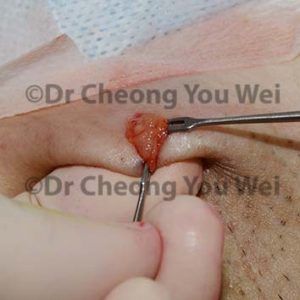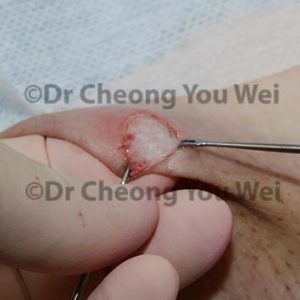There are two types of sweat glands in our body: eccrine sweat glands and apocrine sweat glands. Eccrine sweat glands are much smaller but more numerous than apocrine glands, and they are distributed all over the body. Eccrine glands produce a clear and odourless secretion that mostly consists of water with some trace of salt. Apocrine sweat glands are primarily found in the armpit, areola, and groin. Hormonal changes during puberty cause the apocrine sweat glands to mature and become active. The secretion from apocrine sweat glands is fatty and is more concentrated than the watery secretion produced by eccrine glands. Skin bacteria interact with the apocrine gland secretion and release an acrid smell that is the cause of body odour.
Overactive sweat glands can produce excessive sweating in the armpit, a condition known as axillary hyperhidrosis . On the other hand, body odour (also known as osmidrosis or bromhidrosis) from the armpits is caused by the interaction between skin bacteria and the secretion of overactive apocrine sweat glands. Both excessive sweating (hyperhidrosis) and body odour (bromhidrosis or osmidrosis) may occur together or in isolation.
Body odour can make the person feels embarrassed and distressed to the extent it interferes with his or her daily activities and social functions. Body odour is common in otherwise healthy people, although in some rare cases, the condition may be associated with some endocrine and medical disorders.
There are many treatment modalities for body odour. Short term treatments include over-the-counter antiperspirants and deodorants. Botulinum toxin A (BTA) injection is effective but requires repeated injections. For more effective and long-lasting results, surgical removal of the apocrine glands in the armpits is the treatment of choice. There are several surgical options available for the removal of axillary sweat glands:
-
-
-
Open surgery (subdermal trimming technique) is considered the mainstream treatment. This method is straightforward and effective even though it is associated with a larger incision and slightly longer recovery time.
-
Minimal access surgery (Versajet): Versajet is an hydrosurgery system that was initially designed for wound debridement. Recently the system has become a new treatment tool for axillary hyperhidrosis and osmidrosis. Versajet is very useful in removing axillary sweat glands and delivers excellent results. Water is used as the medium to create a powerful suction force. There is no physical friction between the suction point of the instrument and skin tissue, which avoids collateral tissue injury and heating effects. Compared to the other surgical modalities, this technique has the added advantages of being more precise and gentler to the skin. Other advantages include smaller incisions, shorter operation time, faster recovery, and lower risk of wound complications.
-
Suction-assisted cartilage shaver (rotating blade): a technique in which an arthroscopic cartilage shaver is used to remove the axillary sweat glands.
-
Liposuction: Liposuction is simple to use but may result in inadequate removal of apocrine glands. It is associated with an increased recurrence rate due to incomplete removal of apocrine glands.
Preparation
-
Inform the doctor of any pre-existing medical conditions and drug allergy. All medical conditions must be treated and stabilized before surgery.
-
Stop smoking at least one week before surgery. Smoking is harmful to wound healing and increases the risks of other post-operation complications.
-
Stop the following medications and supplements from one week before surgery until one week after surgery.
-
All supplements containing vitamin E, ginseng, ginkgo, garlic, fish oil, and other ingredients that increase bleeding during the procedure. Other supplements, traditional medicine, and herbs, in which ingredients are unknown, have to stop as well.
-
Medicine that increases bleeding during the procedure such as aspirin, NSAIDs, and warfarin. However, you may need to consult your physician who prescribed the medication before you stop them.
-
On the day of surgery, wear simple and comfortable clothing. Do not wear any makeup. Do not wear any jewelry and metal objects on the face and body.
Surgery
Duration: 1 to 2 hours
Anaesthesia: Local anaesthesia
Hospitalization: Not required
Recovery: Back to work in 3 to 5 days, light exercise after 2 weeks, heavy exercise after at least one month. * The actual speed of recovery depends on the types of procedure performed and may vary from person to person.
Technique:
-
-
-
Open surgery (subdermal trimming technique): A 3 to 4cm incision is made in the axilla. The skin is released from the underlying tissues, and sweat glands are removed under direct vision.
-
Minimal access surgery (Versajet): One or two small incisions (0.5 to 1cm) are made in the treatment area. The skin is undermined, and the Versajet is applied to remove the sweat glands.
-
Suction-assisted cartilage shaver (rotating blade): One or two incisions are made on the affected area. The skin is undermined and the cartilage shaver is inserted to trim and remove the sweat glands.
Post-operative Care**
-
What to expect: Open drains or a suction drain may applied to remove fluid collection or blood from the wound.
-
General care:
-
Avoid smoking for at least one month. Smoking increases the risk of wound complications.
-
Adequate rest and sleep are helpful for a speedy recovery.
-
Sleep on the back and avoid sleeping on one side.
-
Be relaxed and calm. Contact the clinic if there are any queries.
-
Medicine: Finish the oral antibiotics as prescribed. Take the painkiller as prescribed when necessary.
-
Wound care: After the wound dressing is removed, clean the wound with a clean cotton tip soaked with sterile water/saline. Apply antibiotic ointment.
-
Physical activity: Avoid heavy physical activity and exercise for at least one month.
-
Follow-up: Come back one week after surgery for review and suture removal.
-
Emergency: If there is heavy bleeding, a rapid increase in swelling or severe pain, immediately contact the clinic/doctor for advice.
** The instructions in this list are only for general guidance. If you have any specific queries or concerns during the post-operative recovery, please contact the clinic for further advice.



